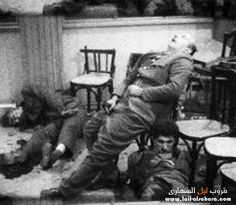On the Day September 5 1981
Sadat Deposes Coptic Pope
Khen Lim
Pope Shenouda III, Patriarch of Alexandria (Image source: en.wikipedia.org)
The Copts have come a long way. As the oldest Christian
community in the Middle East, they have been part of the Egyptian landscape since
the years after Christ’s resurrection in the days of the Apostles. They were
founded on the legacy that the Apostle Mark had left behind in Alexandria a
considerable Christian community from which point, Christianity spread through
the whole of Egypt within fifty years of his arrival.
However, Coptic Christianity has been riven by doctrinal
conflicts, no less the Monophysite Controversy (see note below) during
the fifth century in which they rebuffed the ruling of the Council of Chalcedon
(451AD) concerning the dual simultaneous natures of the one person of Jesus Christ
(called hypostatic union or dyophysitism)
as perfectly embodied in John 1-2.
Instead they adopted the belief that Christ
has only one nature, one that melds the human and the divine, and by doing so,
they created a minority in conflict that alienated them from the rest of the
Church.
* While the Copts prefer to call it ‘Miaphysitism,’ it is the
term ‘monophysite’ that more accurately defines their belief that Christ has
only one nature. ‘Miaphysites,’ on the other hand, alludes to a composite of
both perfectly human and perfectly divine.
Even as the Muslims annexed Egypt in 639AD, the Copts stuck to
their belief and as a result, they paid a very hefty price with countless
martyrdoms. Still they refused to yield in all matters spiritual right through
to the twentieth century.
Meanwhile the stubborn Coptic faith remained their
enduring call card, their followers continued to be hated in the Middle-East.
It didn’t matter that the Qur’an had spoken highly of Christ, that intense
dislike for the Copts was immutable.
The persecution worsened especially after Gamal Abdel Nasser
led the Free Officers Movement, a group of army officers, to revolt against
British rule in 1952.
Institutionalised persecution of Egypt's Coptic Christians today (Image source: raymondibrahim.com)
In fact, once without British protection, the Copts were
subject to a harsh interpretation of Islamic fundamentalism in the form of
public humiliation and abject social discrimination not excluding loss of employment
opportunities. Even their role in helping to secure independence from the
British was conveniently sidelined by the Muslims who then deliberately removed
any documentation of their effort in school textbooks.
After Nasser, President Anwar Sadat attempted to placate the
Copts by tempering Islamic antipathy. He even took part in their culture by
attending a Coptic wedding in 1977 but that only raised the ire of Muslim
fundamentalism who now viewed not only the Copts but also Sadat as their enemy.
For much of the late Seventies to early Eighties, Copts bore the brunt of
Islamic aggression.
Churches were broken into, ransacked and then set ablaze.
When Coptic priests complained and protested, they were thrown into jail while
Coptic Christians everywhere in Egypt were victimised. Their businesses were
looted and their properties vandalised. Christians were taunted and threatened
in public.
In 1976 when the Copts formed an organisation to protest
against persecution, Pope Shenouda III (1923-2012), Patriarch of Alexandria,
was actively involved. His involvement, however, was viewed as a political movement,
one that the Muslim majority mistakenly felt had subversive intentions in which
a breakaway nation was the ultimate goal.
As a result, the Muslims went on a
wild rampage, murdering Coptic priests and their families and destroying a
Coptic seminary. In response, the Copts took to the American media to raise
awareness to their plight but that only angered Sadat who then vowed to punish Shenouda
by persecuting his people.
Soon after the Egyptian media had laid the blame for all
national problems on the Copts, the Muslims resolved to build a mosque on a
piece of land that they had illegally prised from its Coptic owner’s clutches
who then fired his rifle in self-defence, which then led to a three-day siege
between the two religious factions.
Smelling an opportunistic political advantage,
the Muslims pointed to gun ownership as evidence that the Copts were planning a
mass revolt and used that to justify another wave of retaliation in which
Christians were burned to death in their own homes and their babies flung out
of balconies to die.
Even though a few of the Muslim ringleaders were brought to
justice, Sadat released them soon thereafter on ceremonious reasons. Shenouda could
not stomach this injustice and promptly protested.

Assassination of Anwar Sadat, 1981 (Image source: awesomestories.com)
In response, on this day in
1981, after ten years of papacy, Sadat reneged on the 1971 presidential decree of
recognition of his position as Pope of Alexandria and banished him to an
ancient desert monastery in the Nitrian Desert. Even so, Sadat failed to
relinquish Shenouda of his role as leader of the Christians of Egypt and undaunted,
he continued his duties.
After Sadat was assassinated in 1981 by the Islamic extremists
he promoted, Shenouda was given amnesty and reinstated three years later by his
successor, Hosni Mubarak.
No comments:
Post a Comment